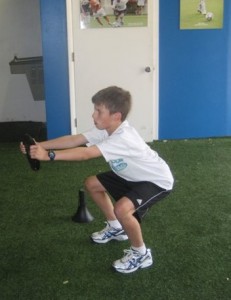By: Calum McLellan, CSCS, NASM-PES
Sports Performance Specialist
Spectrum Sports Performance
 I find so many people have a misconception when it comes to strength training for their children. There are a myriad of reasons why people don’t want to have their child do resistance training, but I want to shed a light on all of the doubt and show how it could be a positive influence on a young athlete’s life.
I find so many people have a misconception when it comes to strength training for their children. There are a myriad of reasons why people don’t want to have their child do resistance training, but I want to shed a light on all of the doubt and show how it could be a positive influence on a young athlete’s life.
Here are a few of the major misconceptions associated with youth strength training…
Resistance training will stunt your child’s growth:FALSE. There have been numerous studies involving children doing weight-bearing activity and none have reported a decrease in stature. Beyond that, resistance training and other physical activity has been shown to be a positive influence on bone growth and development during childhood and adolescence.
Youth Resistance training isn’t safe:FALSE. In fact a youth athlete may be more at risk for injury during the actual sport they play than resistance training under qualified instruction. Even better, strength training can help reduce the chance of injury while on the field. This is due to the increased stability in the joints and strength of the surrounding muscles and connective tissue.
There are certain exercises that youth athletes shouldn’t do:FALSE. There are many exercises and movements that we ask young athletes to do that some of the most elite athletes perform. A classic example of this fallacy is some believe youth should not use free weights such as dumbbells or barbells and should only do body weight exercises such as push ups or pull ups. What is often overlooked is a pull up or a push up is far more demanding than a low weight dumbbell press or pull and could potentially injure the inexperienced athlete. That is why we start them from the ground up, focusing entirely on form and posture and slowly adding weight. There are many times young athletes will lift nothing but a ¼ inch pvc pipe for an entire month before giving them a weight to lift. Form follows function and SSP drives that from the minute they walk in the door.
When it comes to improving performance in young athletes through the use of structured movement and resistance training there are no specific guidelines established. Proper movement patterns are essential for young athletes to master to create an efficient base to build upon. Once they have a firm grasp on the proper movement patterns, logical progressions are made to make the exercise, or movement more difficult. Following this model has given SSP a lot of success in improving young athletes performance and injury prevention. When considering adding resistance training for your young athlete you can now rest assured you are doing something that can only make them better and keep them healthier.
Edited by Courtney VandeStreek
Leave a Reply